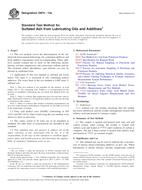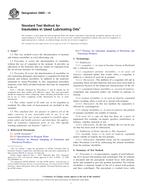We need your consent to use the individual data so that you can see information about your interests, among other things. Click "OK" to give your consent.
ASTM D7412-09
Standard Test Method for Condition Monitoring of Phosphate Antiwear Additives in In-Service Petroleum and Hydrocarbon Based Lubricants by Trend Analysis Using Fourier Transform Infrared (FT-IR) Spectrometry
STANDARD published on 1.7.2009
The information about the standard:
Designation standards: ASTM D7412-09
Note: WITHDRAWN
Publication date standards: 1.7.2009
SKU: NS-38392
The number of pages: 5
Approximate weight : 15 g (0.03 lbs)
Country: American technical standard
Category: Technical standards ASTM
The category - similar standards:
Annotation of standard text ASTM D7412-09 :
Keywords:
condition monitoring, differential trend analysis, direct trend analysis, Fourier transform infrared, FT-IR, hydrocarbon based lubricants, in-service petroleum lubricants, infrared, IR, lubricants, oils, phosphate antiwear, ICS Number Code 75.100 (Lubricants, industrial oils and related products)
Additional information
| Significance and Use | ||||||||||||||||||
|
Antiwear additives are commonly used in petroleum and hydrocarbon based lubricants to prevent machinery wear by forming a chemical barrier activated by frictional heat. Antiwear additives that are phosphate based can be measured by FT-IR spectroscopy using the phosphate absorption band. Initially, phosphate antiwear additives will decompose and form a protective film by binding to metal surfaces and through oxidative mechanisms, and so a decrease in the level of phosphate antiwear additive relative to that in the new oil is expected during normal machinery operation. Subsequently, significant depletion of phosphate antiwear additives due to oxidation or hydrolysis can occur when the lubricant is subjected to high temperatures and high levels of moisture. This usually occurs prior to the point where the oxidation of the lubricant begins to accelerate—making trending of phosphate antiwear additives a useful indicator of the lubricant’s remaining in-service life. Monitoring of phosphate antiwear additive depletion is therefore an important parameter in determining overall machinery health and should be considered in conjunction with data from other tests such as atomic emission (AE) and atomic absorption (AA) spectroscopy for wear metal analysis (Test Method D 5185), physical property tests (Test Methods D 445, D 2896, and D 6304) and other FT-IR oil analysis methods for oxidation (Test Method D 7414), sulfate by-products (Test Method D 7415), nitration, breakdown products and external contaminants (Practice E 2412), which also assess elements of the oil’s condition, see Refs (1-6). |
||||||||||||||||||
| 1. Scope | ||||||||||||||||||
|
1.1 This test method covers monitoring phosphate antiwear additives in in-service petroleum and hydrocarbon based lubricants such as various types of engine oils, hydraulic oils, and other lubricants that are formulated for protection against wear. Typical phosphate antiwear additives include zinc dialkyldithiophosphates, trialkyl phosphates and triaryl phosphates. 1.2 This test method uses Fourier Transform Infrared (FT-IR) spectrometry for monitoring of phosphate antiwear additive depletion in in-service petroleum and hydrocarbon based lubricants as a result of normal machinery operation. Monitoring the depletion of phosphate antiwear additives in in-service lubricants can indicate unusual wear or severe operating conditions of the machine. This test method is designed as a fast, simple spectroscopic check for monitoring of phosphate antiwear additives in in-service petroleum and hydrocarbon based lubricants with the objective of helping diagnose the operational condition of the machine based on measuring the level of phosphate antiwear additives in the oil. 1.3 Acquisition of FT-IR spectral data for measuring phosphate antiwear additives in in-service oil and lubricant samples is described in Practice D 7418. In this test method, measurement and data interpretation parameters for phosphate antiwear additives using both direct trend analysis and differential (spectral subtraction) trend analysis are presented. 1.4 This test method is based on trending of spectral changes associated with phosphate antiwear additives in in-service petroleum and hydrocarbon based lubricants. Warnings or alarm limits can be set on the basis of a fixed minimum value for a single measurement or, alternatively, can be based on a rate of change of the response measured, see Ref (1). 1.4.1 For direct trend analysis, values are recorded directly from absorption spectra and reported in units of absorbance per 0.1 mm pathlength. 1.4.2 For differential trend analysis, values are recorded from the differential spectra (spectrum obtained by subtraction of the absorption spectrum of the reference oil from that of the in-service oil) and reported in units of 100*absorbance per 0.1 mm pathlength (or equivalently absorbance units per centimeter). 1.4.3 In either case, maintenance action limits should be determined through statistical analysis, history of the same or similar equipment, round robin tests or other methods in conjunction with the correlation of changes in the level of phosphate antiwear additives to equipment performance. Note 1—It is not the intent of this test method to establish or recommend normal, cautionary, warning or alert limits for any machinery. Such limits should be established in conjunction with advice and guidance from the machinery manufacturer and maintenance group. 1.5 This test method is for petroleum and hydrocarbon based lubricants and is not applicable for ester based oils, including polyol esters or phosphate esters. 1.6 The values stated in SI units are to be regarded as standard. No other units of measurement are included in this standard. 1.6.1 Exception—The unit for wave numbers is cm-1. 1.7 This standard does not purport to address all of the safety concerns, if any, associated with its use. It is the responsibility of the user of this standard to establish appropriate safety and health practices and determine the applicability of regulatory limitations prior to use. |
||||||||||||||||||
| 2. Referenced Documents | ||||||||||||||||||
|
Similar standards:
Historical
1.9.2013
Historical
15.6.2013
Historical
1.5.2014
Historical
1.11.2012
Historical
1.5.2007
Historical
1.5.2012



 ASTM D874-13a
ASTM D874-13a ASTM D892-13
ASTM D892-13 ASTM D893-14
ASTM D893-14 ASTM D91-02(2012)..
ASTM D91-02(2012).. ASTM D942-02(2007)..
ASTM D942-02(2007).. ASTM D971-12
ASTM D971-12 Cookies
Cookies
